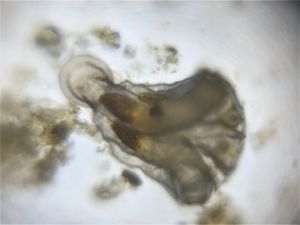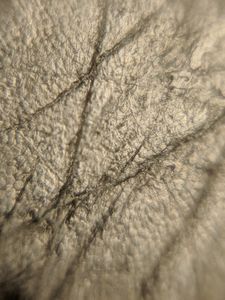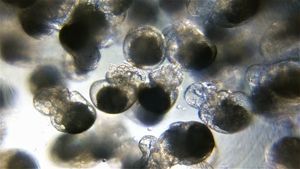Moldy Lunch
 Dec 22, 2018 • 11:49 PM UTC
Dec 22, 2018 • 11:49 PM UTC United States
United States 140x Magnification
140x Magnification Fungi
Fungi
RebeccaKonte
Scientific artist, using art as a tool for scientific storytelling. http://www.rebeccakonte.com/
27posts
25comments
22locations

Cleaning out the fridge at work, I noticed an old lunch of mine had become quite fantastically moldy. Seeing this little forest of cellular trees reminded me of a story I recently came across about microbes, artwork, and preservation…




To recap the story:
Microbes are around us all the time in spore form, and when they land on a surface (if there’s moisture), they’ll begin to grow. Surfaces like paintings, monuments, and all kinds of artwork are no exception. Microbes can feed on pigments, oils, canvas, all the like… And if you leave them long enough, they’ll erode away, eat at the foundation, and maybe even flake off paint. That’s a nightmare for conservationists, so they enlist the help of biologists to protect aging works of art. 🙂
Here are links to a podcast and a paper that tell this story in detail, in case you want to know more. I found the podcast here super interesting, it talks about how artwork is preserved in a microbial world. And the paper here is what sparked the podcast segment, a study where researchers analyzed a 17th century painting and found microbes that could degrade and others that could protect the painting.
—
In this post, I looked at the mold growing on my lunch.
From a quick search I think this mold is Rhizopus stolonifer, a super common fungus, and what you see on the surface of the rotting apples and grapes are long mycelial stolons with black sporangia. Here’s what they look like through the foldscope:
Microbes are around us all the time in spore form, and when they land on a surface (if there’s moisture), they’ll begin to grow. Surfaces like paintings, monuments, and all kinds of artwork are no exception. Microbes can feed on pigments, oils, canvas, all the like… And if you leave them long enough, they’ll erode away, eat at the foundation, and maybe even flake off paint. That’s a nightmare for conservationists, so they enlist the help of biologists to protect aging works of art. 🙂
Here are links to a podcast and a paper that tell this story in detail, in case you want to know more. I found the podcast here super interesting, it talks about how artwork is preserved in a microbial world. And the paper here is what sparked the podcast segment, a study where researchers analyzed a 17th century painting and found microbes that could degrade and others that could protect the painting.
—
In this post, I looked at the mold growing on my lunch.
From a quick search I think this mold is Rhizopus stolonifer, a super common fungus, and what you see on the surface of the rotting apples and grapes are long mycelial stolons with black sporangia. Here’s what they look like through the foldscope:












A couple observations:
The particles around the perimeter of the smooshed sorangia looked red, I found that strange/ it stuck out? The sporangia also had a surprisng texture. As soon as they met a surface, they seemed to liquify. I tried to capture this in the photos below. For whatever reason, I expected their texture to be dry, dust-like. It made slide-making tricky to view their structures intact as they formed a blackish soup as soon as they touched the slide… But maybe this is helpful for their methods of propagation? It seemed to make sense as I saw something similar on the skin of the apple, where black spores seemed to seep into the fruit like watercolor.
The particles around the perimeter of the smooshed sorangia looked red, I found that strange/ it stuck out? The sporangia also had a surprisng texture. As soon as they met a surface, they seemed to liquify. I tried to capture this in the photos below. For whatever reason, I expected their texture to be dry, dust-like. It made slide-making tricky to view their structures intact as they formed a blackish soup as soon as they touched the slide… But maybe this is helpful for their methods of propagation? It seemed to make sense as I saw something similar on the skin of the apple, where black spores seemed to seep into the fruit like watercolor.

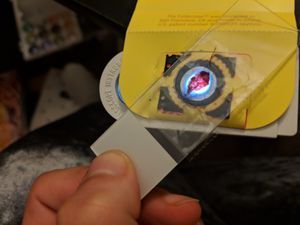
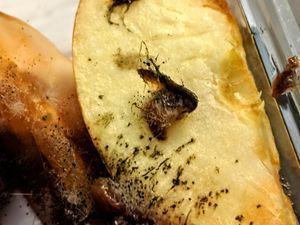
If any fungi-enthusiasts see this, let me know any comments/corrections/what you think!
Until next time,
Rebecca
Until next time,
Rebecca
Sign in to commentNobody has commented yet... Share your thoughts with the author and start the discussion!
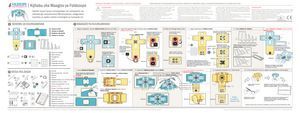
 0 Applause
0 Applause 0 Comments
0 Comments



